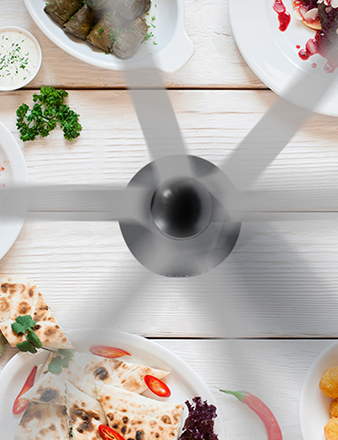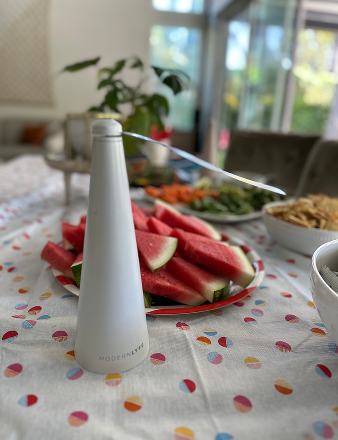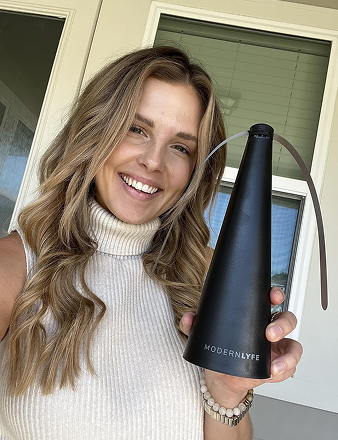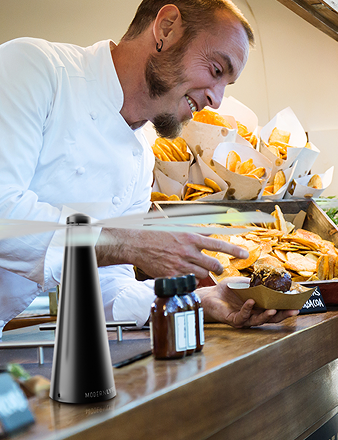Stuck in a stuffy room or sweating on the patio? The simplest solution is often the best: a battery operated table fan. These compact powerhouses deliver go-anywhere cooling, providing comfort from the home office to the campsite—no outlet required.
Why Portable Fans Are a Modern Essential
We live in a world built on flexibility. We work, relax, and socialize in different spots, and our gadgets need to keep up. Battery operated table fans are a perfect example of this shift, moving from niche gizmos to practical, everyday tools that free us from cords.
The numbers back this up. The global market for portable electric fans was valued at USD 3.2 billion in 2023 and is projected to hit USD 5.5 billion by 2032. That growth reflects a clear demand for compact, efficient cooling that fits the way we live now.
The Power of Untethered Comfort
The magic of these fans is their convenience. Think of all the times a corded fan just won't work:
- Outdoor Dining: Enjoy a meal on the deck without being swarmed. Specialized fly fans for tables are designed for this.
- Power Outages: When the lights go out, a battery-powered fan keeps air moving, providing crucial comfort when you need it most.
- Cluttered Workspaces: Cool down your desk without adding another cable to the tangle of wires behind your screen.
The real value of a battery operated fan is its ability to deliver targeted cooling exactly where you need it, when you need it—no extension cords required.
These fans are part of a larger trend. The same advances in mobile energy solutions that give us long-lasting smartphones now power our personal comfort. High-capacity battery technology makes untethered cooling possible, fundamentally changing the game for everyday convenience.
Decoding Your Next Fan's Features
Choosing a battery operated table fan is easy once you know what to look for. Beyond just blades and a motor, a few key features separate a great fan from a gadget that collects dust.
Think of the battery as the fan's fuel tank. Its capacity, measured in milliampere-hours (mAh), dictates its runtime. A higher number means more power. A small personal fan might have a 2000mAh battery for a few hours of use, while a larger model could pack 10,000mAh or more—enough to last all day.
This infographic breaks down how these crucial elements work together to deliver the perfect portable breeze, keeping you cool anywhere.
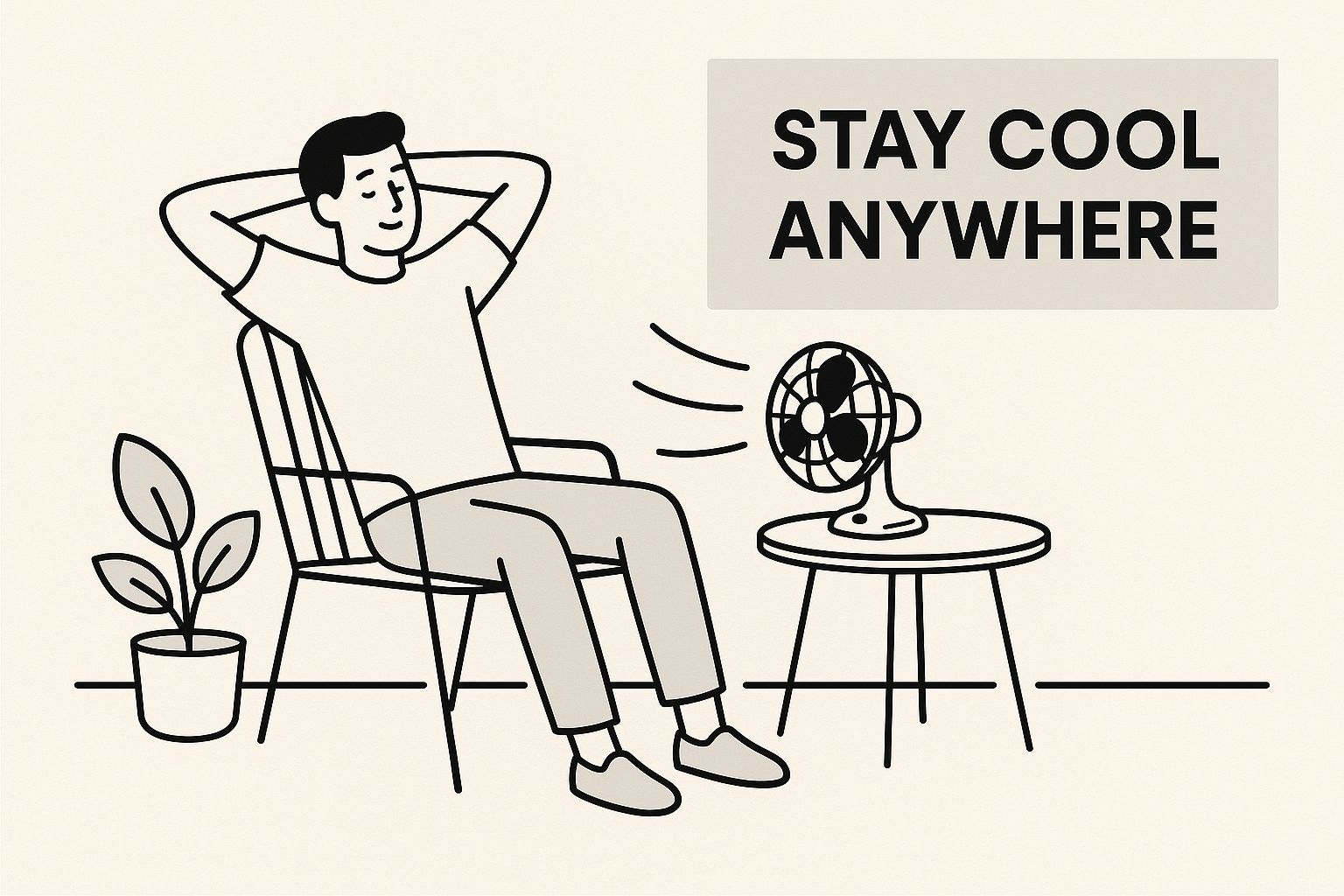
As you can see, a powerful battery, a quiet motor, and strong airflow are the three pillars of a quality portable fan. They must work in sync to deliver on the promise of comfort.
The Engine Powering Your Breeze
The motor is the heart of any fan. Today, many battery operated fans use brushless DC motors—a massive upgrade from the noisy motors of the past.
A brushless motor is the gold standard for two reasons: it's incredibly quiet and highly energy-efficient. It creates less friction and heat, meaning more battery power goes directly to spinning the blades. The result is longer runtimes and less noise.
This efficiency is a game-changer for a portable device where every minute of battery life counts. It's what allows a fan to run for hours without being a distraction in a quiet office or disrupting your sleep.
Airflow and Charging Smarts
How much air does the fan move? This is measured in Cubic Feet per Minute (CFM). While not always listed on smaller fans, a higher CFM means more powerful airflow. Multiple speed settings are also a must-have, giving you control from a gentle whisper to a strong, cooling gust.
Let's break down the most important specs and what they mean for your daily use.
Key Fan Features and What They Mean for You
| Feature | What It Means for You | Why It Matters |
|---|---|---|
| Battery Capacity (mAh) | How long the fan runs on a single charge. | Higher mAh means more freedom from the wall, perfect for long days or outdoor use. |
| Motor Type | The engine's efficiency and noise level. | A brushless DC motor is quieter, lasts longer, and extends battery life. |
| Airflow (CFM) | The volume of air the fan moves per minute. | A higher CFM provides stronger, more effective cooling over a larger area. |
| Charging Port | How you power up the battery. | USB-C is the modern standard, letting you use the same cable as your phone or laptop. |
| Speed Settings | The number of different fan speeds available. | Gives you the flexibility to choose between a silent breeze and maximum cooling power. |
Understanding these basics helps you cut through the marketing hype and focus on what delivers real value.
Finally, consider extra features. Some fans are purely for cooling, while others are specialized. For example, understanding how fly fans work reveals a design specifically meant to keep pests away during a barbecue. Other handy extras include:
- Oscillation: The fan head swivels side-to-side, distributing cool air across a wider area.
- Adjustable Tilt: Angle the fan head up or down to direct the breeze exactly where you want it.
- LED Lighting: A built-in light turns your fan into a great tool for camping or a backup during a power outage.
Once you master these core components—battery, motor, airflow, and charging—you can look at any product and know exactly what you're getting. You'll be able to confidently choose a battery operated table fan that’s quiet, effective, and ready when you need it.
How to Choose the Right Portable Fan
Now that you know the tech, let's find the perfect fan for you. The right battery operated table fan isn’t the one with the most features; it’s the one that matches your life. Think of it like casting a role—the quiet, subtle fan for your office is a different choice than the powerhouse you need for the patio.
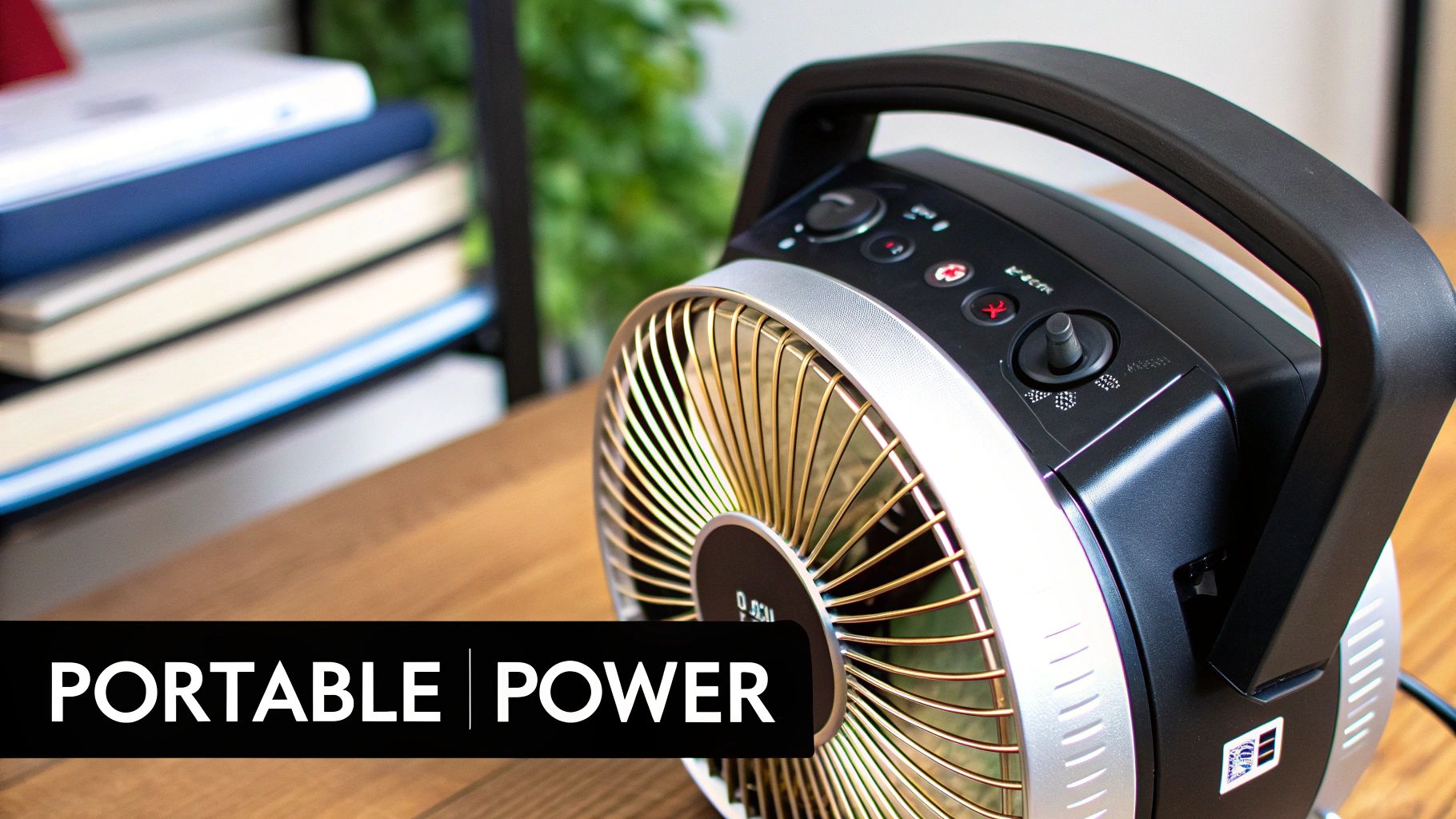
You're not alone in searching for one. The personal portable fan market is set to more than double, growing from USD 0.59 billion in 2025 to an estimated USD 1.23 billion by 2035. This explosive growth is driven by everything from outdoor events to the simple need for a breeze in a city apartment, proving just how essential these gadgets have become. You can dive into more data on the personal portable fan market to see the full picture.
Start With Your Primary Use Case
Before looking at any products, ask yourself one question: where will this fan be used most? Your answer immediately clarifies which features are must-haves.
-
For the Office Desk: Quiet operation is non-negotiable. Look for models with a low decibel (dB) rating—under 30dB on its lowest setting is virtually silent. A compact footprint and an adjustable head are also key for targeted airflow that doesn't blow papers around.
-
For Outdoor Adventures: Durability and battery life are paramount. You need a fan with a rugged build that can handle being packed in a bag and a high-capacity battery (8,000mAh or more) to last through a weekend camping trip. A built-in LED light is a fantastic bonus.
-
For Home and Patios: Look for a balance of power and versatility. Oscillation is great for circulating air across a wider area, making it comfortable for more than one person. A timer function is another great perk, letting you fall asleep to a breeze without the fan running all night.
Choosing a fan is like picking a tool. You wouldn't use a small hammer to build a deck. First, define the job—quiet focus at work, rugged comfort outdoors, or versatile cooling at home—and the right choice becomes clear.
Balance Power with Portability
There's usually a trade-off between a fan's power and its portability. A larger fan with bigger blades will move more air (higher CFM), but it will also be heavier and bulkier.
If your priority is a fan you can easily toss in a backpack, focus on a lightweight, compact design. If the fan will mostly move from your kitchen to the back porch, you can opt for a slightly larger, more powerful model. Be honest about what’s a “must-have” versus a “nice-to-have” for your lifestyle.
Don't Forget Noise and Smart Features
Finally, consider the small details that make a big difference. Noise level is a major factor, especially for light sleepers or those in quiet workspaces.
Here are a few final features to watch for:
- Noise Level (dB): Crucial for bedrooms and offices. For peaceful operation, look for fans with specs below 40dB.
- Timer Functions: A great battery-saver and perfect for nighttime use.
- Remote Control: Pure convenience. Adjusting settings from your bed or couch is a game-changer.
- Clip-On Design: Versatile fans often have a sturdy clip, letting you attach them to shelves, strollers, or tent poles.
By focusing on your primary use, the power-portability balance, and quality-of-life extras, you can cut through the noise. You’ll be able to choose a battery operated table fan that doesn’t just work well but fits seamlessly into your life.
Where Your Cordless Fan Shines
Specs and features are one thing, but the real value of a battery operated table fan emerges in its application. These are not just gadgets; they are problem-solvers for any spot where a corded fan is impractical. Let's explore where this cordless freedom truly makes a difference.
Imagine your home office on a hot afternoon. You need a breeze, but the only outlet is across the room. Instead of tripping over an extension cord, you can place a compact, battery-powered fan right on your desk for instant, quiet cooling without the cable clutter.
From Nurseries to Power Outages
It's not just about decluttering. In a baby's nursery, where safety is paramount, a cordless fan eliminates dangling cords that little hands could grab. Its near-silent operation, often under 30 decibels, provides a gentle breeze without waking a sleeping infant.
Then there's the unexpected power outage. While others swelter in the still air, your fully charged fan becomes a lifesaver. A model with a high-capacity battery—10,000mAh or more—can run for hours, keeping the air moving until the power returns.
The genius of a battery operated table fan is its seamless transition from daily convenience to emergency essential. It’s the tool you appreciate during a stuffy meeting and are truly grateful for during a summer blackout.
Your Go-Anywhere Comfort Companion
The grab-and-go nature of these fans revolutionizes outdoor activities. Enjoy dinner on the patio without pests, or create a personal cool zone at a crowded event like Dîner en Blanc, where a "Battery operated table fan" is often a recommended item.
This portability is also a huge win for camping. A good fan can transform a hot, stuffy tent into a comfortable space, circulating air for a better night's sleep. Some models even include a built-in LED light, serving as both a fan and a lantern. While kitting out your gear, consider other top camping accessories that pair well with a portable fan.
From the backyard to the backcountry, a cordless fan is your ticket to staying cool and comfortable, no matter where you are.
Getting the Most from Your Fan
You've chosen the perfect battery operated table fan. Now, let's keep it running like new. A little routine maintenance extends its life and ensures a strong, steady breeze every time you switch it on.
The battery is the heart of any cordless fan, and its health dictates performance. With the global table fan market—where battery models are a fast-growing segment—hitting USD 4.1 billion in 2023 and projected to reach USD 6.9 billion by 2032, proper care is more critical than ever. You can explore these insights on the table fans market for a deeper dive.
Smart Battery Care for Longevity
The biggest mistake is running the battery completely dead. Most modern fans use lithium-ion batteries, which perform better with partial discharges.
Instead of waiting for the power to drain, plug it in when the battery hits around 20%. This simple habit reduces stress on the battery cells and can significantly extend its lifespan. If you often use your fan while it's plugged in, make a point to occasionally unplug it and let it run on battery power.
Treat your fan's battery like a modern smartphone, not an old flip phone. It doesn't have a "memory" and doesn't need to be fully drained. Think of it as topping off the tank, not running on fumes.
Simple Cleaning for Better Airflow
Dust and grime will inevitably build up on the fan blades and grille. This isn't just cosmetic; buildup obstructs airflow, forcing the motor to work harder and draining the battery faster. Luckily, the fix is easy.
Follow these steps every few weeks:
- Power Down and Unplug: Always ensure the fan is off and disconnected from any power source first.
- Remove the Grille: On most fans, the front grille twists or unclips. Check the user manual if you're unsure.
- Wipe It Clean: Use a soft, dry cloth. For tougher grime, a slightly damp cloth can be used on the blades and grille.
- Detail the Vents: A can of compressed air or a small, soft brush is perfect for clearing dust from motor vents and other tight spots.
Storing Your Fan During the Off-Season
When cooler weather arrives, don't just shove your fan in a closet. Proper storage sets it up for success next year.
First, give it a thorough cleaning. Most importantly, charge the battery to about 50%. Leaving a battery fully charged or completely empty for long periods can cause it to degrade. Store it in a cool, dry place away from extreme temperatures. A little prep now ensures your fan is ready the moment you need it again.
Still Have Questions About Battery Fans?
It's normal to have a few questions. Let's tackle the most common ones to ensure you can choose your fan with complete confidence.
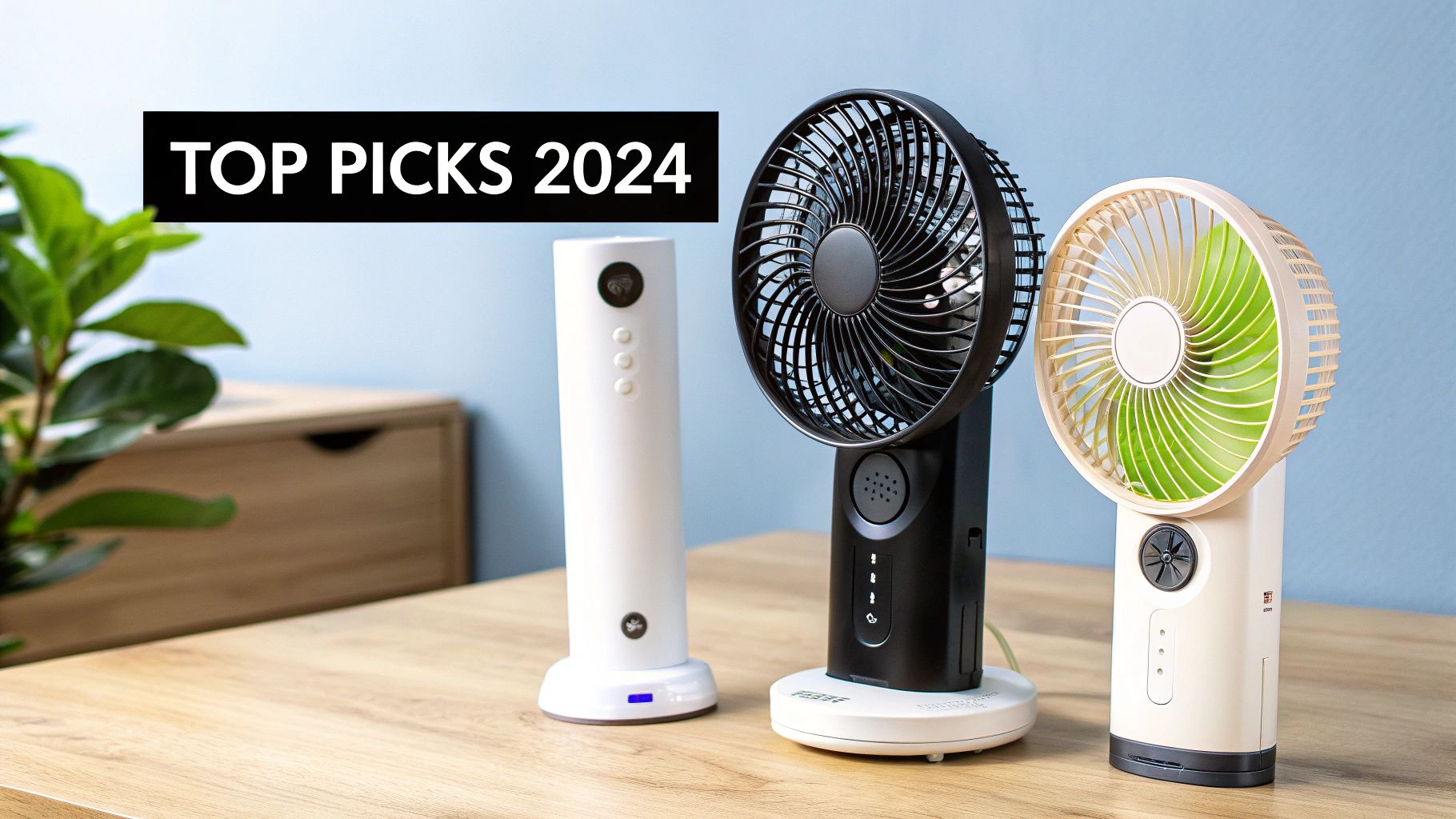
We've covered the tech, use cases, and maintenance. Now, let’s clear up those final details.
How Long Do Battery Operated Fans Actually Run?
The honest answer: it depends. A fan's runtime is determined by its battery capacity (mAh) and the speed setting you use.
On average, expect a runtime between 4 to 24 hours. A small personal fan on its highest setting might last 4-8 hours. A larger model with a high-capacity battery (over 5,000mAh) could easily run all day or through the night on a low setting. Always check the manufacturer's specs for runtimes at different speeds.
Can I Use the Fan While It's Charging?
Yes. Most modern battery fans support "pass-through" charging. This essential feature allows the fan to operate while plugged into a USB power source.
This effectively turns your portable fan into a standard desk fan whenever you're near an outlet, giving you a continuous breeze without waiting for a full charge. While common, it's always smart to confirm this feature in the product description.
Are These Fans Strong Enough to Cool a Room?
Let's set the right expectation: these fans excel at personal cooling, not whole-room climate control. Their job is to create a comfortable bubble of cool air around you, whether you're at your desk, on the patio, or in a tent.
Think of your fan as a personal comfort tool, not an air conditioner substitute. Its strength is delivering a focused stream of air exactly where you need it most.
A powerful model can certainly help circulate air in a small space, but its primary purpose is to cool you, not the entire room. For that targeted relief, they are unbeatable.
What's the Best Way to Clean a Portable Fan?
Keeping your fan clean is simple and significantly impacts its performance and lifespan. A clean fan moves air more efficiently and prevents the motor from overworking.
First, ensure the fan is off and unplugged. Most have a removable front grille for easy access to the blades.
- Wipe Down Blades and Grille: A dry or slightly damp microfiber cloth works perfectly for dust.
- Clear Out Vents: Use a soft brush or a can of compressed air for the motor housing and other tight spots.
- Avoid Liquids and Chemicals: Never use harsh cleaning sprays or submerge any part of the fan in water, as this can damage the electronics.
A quick wipe-down every few weeks is all it takes to keep your fan running like new.
Ready to find the perfect fan for your space? The MODERN LYFE collection offers elegant, quiet, and effective solutions designed to keep you comfortable without the clutter of cords. Whether you’re hosting a dinner party or just want a personal breeze, we have a fan that fits your life. Explore our collection and stay cool with MODERN LYFE.

